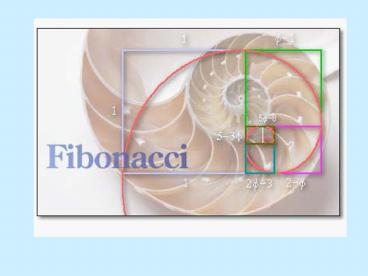FIBONACCI - PowerPoint PPT Presentation
1 / 23
Title: FIBONACCI
1
(No Transcript)
2
Biography (1170-1250)
- Fibonacci is a short for the Latin "filius
Bonacci" which means - "the son of Bonacci" but his full name was
Leonardo of Pisa, or - Leonardo Pisano in Italian since he was born in
Pisa (Italy). - He was educated in North Africa where his father
worked as a merchant. - Fibonacci travelled widely with his father
around the Mediterranean coast . - In 1200 he returned to Pisa and used the
knowledge he had gained on his travels to write
his books.
3
Books
- Liber Abaci (1202), The Book of Calculation
- Practica Geometriae (1220), The Practice of
Geometry - Flos (1225), The Flower
- Liber Quadratorum (1225),The Book of Square
Numbers
4
The Flower
- the approximate solution of the following cubic
equation - x³2x²10x20
- in sexagesimal notation is 1.22.7.42.33.4.40 ,
equivalent to
5
The Book of Square Numbers
- Method to find Pythogorean triples
- When you wish to find two square numbers
whose addition produces a square number, you take
any odd square number as one of the two square
numbers and you find the other square number by
the addition of all the odd numbers from unity up
to but excluding the odd square number. For
example, you take 9 as one of the two squares
mentioned the remaining square will be obtained
by the addition of all the odd numbers below 9,
namely 1, 3, 5, 7, whose sum is 16, a square
number, which when added to 9 gives 25, a square
number.
6
Liber Abaci
- The book introduced the Hindu-Arabic number
system into Europe , the system we use today,
based on ten digits with its decimal point and a
symbol for zero - 1 2 3 4 5 6 7 8 9 0
- The book describes (in Latin) the rules for
adding numbers, subtracting, multiplying and
dividing.
7
Rabbits
- Suppose a newly-born pair of rabbits ( male
female) are put in a field. Rabbits are able to
mate at the age of one month so that at the end
of its second month a female can produce another
pair of rabbits. Suppose that our rabbits never
die and that the female always produces one new
pair ( male female) every month from the second
month on. - How many pairs will
- there be in one year?!
8
Answer
- At the end of the first month, they mate, but
there is still only 1 pair - At the end of the second month the female
produces a new pair, so now there are 2 pairs of
rabbits in the field. - At the end of the third month, the original
female produces a second pair, making 3 pairs in
all in the field. - At the end of the fourth month, the original
female has produced yet another new pair, the
female born two months ago produces her first
pair also, making 5 pairs..
9
(No Transcript)
10
We get the following sequence of numbers 1, 1,
2, 3, 5, 8, 13, 21, 34 ...
- This sequence, in which each number is a sum of
two previous is called Fibonacci sequence so
there is the simple rule add the last two to get
the next! - The Fibonacci numbers are the sequence of numbers
defined by the linear recurrence equation - F(n)F(n-1)F(n-2)
11
Fibonacci Rectangles
- We start with two small squares of size 1 next to
each other. On top of both of these we draw a
square of size 2 (11). We can now draw a new
square - touching both a unit square and the
latest square of side 2 - so having sides 3 units
long and then another touching both the 2-square
and the 3-square (which has sides of 5 units). We
can continue adding squares around the picture,
each new square having a side which is as long as
the sum of the latest two square's sides. This
set of rectangles whose sides are two successive
Fibonacci numbers in length and which are
composed of squares with sides which are
Fibonacci numbers, we call the Fibonacci
Rectangles.
12
Rectangles
13
- Fibonacci spirals
- A spiral drawn in the squares, a quarter of a
circle in each square.
14
PASCALS TRIANGLE
15
Nature
- One of the most fascinating things about the
Fibonacci numbers is their connection to nature. - the number of petals, leaves and branches
- spiral patterns in shells
- spirals of the sunflower head
- pineapple scales
16
Flowers
17
(No Transcript)
18
Nautilus
19
Sun
- Flower
20
Pineapple
21
Conclusion
- The greatest European mathematician of the middle
age, most famous for the Fibonacci sequence, in
which each number is the sum of the previous two
and for his role - in the introduction to Europe
- of the modern
- Arabic decimal system.
22
HAPPY EASTER!!!
23
THE ENDBYE































